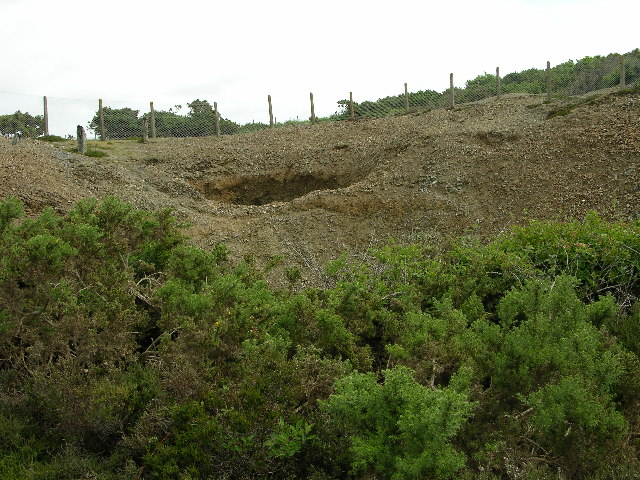|
Bettertonite
Bettertonite is a mineral of the arsenate category, named after John Betterton. He is a museum geologist and mineralogist at Haslemere Educational Museum in Surrey, England. Bettertonite is a white arsenate mineral with a formula of l6(AsO4)3(OH)9(H2O)5ƒ»11H2O. Bettertonite is in the monoclinic system and has a heteropolyhedral layered structure type. It is a natural forming polyoxometalate. Bettertonite forms in clusters of radiating rectangular laths. Laths are thin and usually < 20 μm laterally. Laths are flat on . Bettertonite is similar to penberthycroftyite and it transforms into penberthycroftyite at low temperatures (67-97 °C). Physical Properties Bettertonite is a white and translucent mineral. It has a vitreous and silky to pearly luster. It has a calculated density of 2.02 g/cm3. Bettertonite has perfect cleavage on . Bettertonite’s hardness and fracture were not observed. Bettertonite is nonpleochroic and biaxially p ...[...More Info...] [...Related Items...] OR: [Wikipedia] [Google] [Baidu] |
Arsenate
The arsenate ion is . An arsenate (compound) is any compound that contains this ion. Arsenates are salts or esters of arsenic acid. The arsenic atom in arsenate has a valency of 5 and is also known as pentavalent arsenic or As(V). Arsenate resembles phosphate in many respects, since arsenic and phosphorus occur in the same group (column) of the periodic table. Arsenates are moderate oxidizers, with an electrode potential of +0.56 V for reduction to arsenites. Occurrence Arsenates occur naturally in a variety of minerals. Those minerals may contain hydrated or anhydrous arsenates. Unlike phosphates, arsenates are not lost from a mineral during weathering. Examples of arsenate-containing minerals include adamite, alarsite, annabergite, erythrite and legrandite. Where two arsenate ions are required to balance the charge in a formula, it is called diarsenate for example trizinc diarsenate, Zn3(AsO4)2. Ions The word arsenate is derived from arsenic acid, H3AsO4. This mode ... [...More Info...] [...Related Items...] OR: [Wikipedia] [Google] [Baidu] |
Monoclinic Crystal System
In crystallography, the monoclinic crystal system is one of the seven crystal systems. A crystal system is described by three vectors. In the monoclinic system, the crystal is described by vectors of unequal lengths, as in the orthorhombic system. They form a parallelogram prism. Hence two pairs of vectors are perpendicular (meet at right angles), while the third pair makes an angle other than 90°. Bravais lattices Two monoclinic Bravais lattices exist: the primitive monoclinic and the base-centered monoclinic. For the base-centered monoclinic lattice, the primitive cell has the shape of an oblique rhombic prism;See , row mC, column Primitive, where the cell parameters are given as a1 = a2, α = β it can be constructed because the two-dimensional centered rectangular base layer can also be described with primitive rhombic axes. Note that the length a of the primitive cell below equals \frac \sqrt of the conventional cell above. Crystal classes The table below organ ... [...More Info...] [...Related Items...] OR: [Wikipedia] [Google] [Baidu] |
Arsenate
The arsenate ion is . An arsenate (compound) is any compound that contains this ion. Arsenates are salts or esters of arsenic acid. The arsenic atom in arsenate has a valency of 5 and is also known as pentavalent arsenic or As(V). Arsenate resembles phosphate in many respects, since arsenic and phosphorus occur in the same group (column) of the periodic table. Arsenates are moderate oxidizers, with an electrode potential of +0.56 V for reduction to arsenites. Occurrence Arsenates occur naturally in a variety of minerals. Those minerals may contain hydrated or anhydrous arsenates. Unlike phosphates, arsenates are not lost from a mineral during weathering. Examples of arsenate-containing minerals include adamite, alarsite, annabergite, erythrite and legrandite. Where two arsenate ions are required to balance the charge in a formula, it is called diarsenate for example trizinc diarsenate, Zn3(AsO4)2. Ions The word arsenate is derived from arsenic acid, H3AsO4. This mode ... [...More Info...] [...Related Items...] OR: [Wikipedia] [Google] [Baidu] |
Penberthy Croft Mine
Penberthy Croft Mine, is a disused mine and Site of Special Scientific Interest (SSSI) in Cornwall, England, UK. It is located to the north of the civil parish of St Hilary, east of the town of Penzance. The mine was designated a SSSI in 1993, is listed as of national importance in the Geological Conservation Review and is the world type locality for connellite and bayldonite. It is noted as the most important site in Britain for secondary ore minerals of lead, copper, and arsenic Arsenic is a chemical element with the symbol As and atomic number 33. Arsenic occurs in many minerals, usually in combination with sulfur and metals, but also as a pure elemental crystal. Arsenic is a metalloid. It has various allotropes, but ... and has had 40 mineral species recorded at the site. History A new 36-inch cylinder pumping engine was built in 1880, by Messrs George Eustice and Cooper which drained between nine and ten fathoms of water in the first four hours of work. Referenc ... [...More Info...] [...Related Items...] OR: [Wikipedia] [Google] [Baidu] |
List Of Minerals
This is a list of minerals for which there are articles on Wikipedia. Minerals are distinguished by various chemical and physical properties. Differences in chemical composition and crystal structure distinguish the various ''species''. Within a mineral species there may be variation in physical properties or minor amounts of impurities that are recognized by mineralogists or wider society as a mineral ''variety''. Mineral variety names are listed after the valid minerals for each letter. For a more complete listing of all mineral names, see List of minerals recognized by the International Mineralogical Association. A :Varieties that are not valid species: *Adamantine spar (variety of corundum) *Agate (variety of chalcedony and quartz) *Alabaster (variety of gypsum) *Alexandrite (variety of chrysoberyl) *Allingite (synonym of amber) *Alum *Amazonite (variety of microcline) *Amethyst (purple variety of quartz) *Ametrine (variety of quartz) *Ammolite (organic; also a gems ... [...More Info...] [...Related Items...] OR: [Wikipedia] [Google] [Baidu] |

